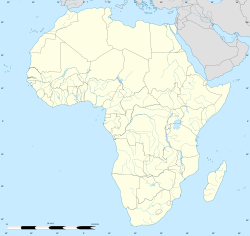Sabata (Oromo: Sabbataa) is a town in the Oromia Special Zone Surrounding Addis Ababa of the Oromia Region in Ethiopia.
Sabata | |
|---|---|
Town | |
| Coordinates: 8°54′40″N 38°37′17″E / 8.91111°N 38.62139°E | |
| Country | |
| Region | |
| Zone | Oromia Special Zone Surrounding Finfinne |
| Elevation | 2,356 m (7,730 ft) |
| Population (2007) | |
• Total | 49,331 |
| Time zone | UTC+3 (EAT) |
| Climate | Cwb |
The Sabataa School for the Blind is located in Sabata. It became part of the Haile Selassie I Foundation in 1959, and construction on a new building began on 4 October 1962.[1] The Ethiopian Institute of Agricultural Research opened a research station in Sabata in 1967, which operates as the national center for research into improving fishing yields.[2]
History
editA plot to kill the Emperor near Sabata with a land mine in the road was discovered on 16 November 1969. Eight people were arrested, and the leader, 76-year-old Tekle Wolde Hawariat, killed himself next day after a gun battle with police at his home in Addis Ababa. He was mentioned without dishonor in the Ethiopian media because of his valuable service to the country in previous years.[1]
A congregation of the Mekane Yesus Church was established in 1979. The congregation's church was burnt by a mob in April 1994, and the leaders of the Ethiopian Orthodox Church afterwards failed to condemn the act.[1]
Demographics
editThe 2007 national census reported a total population for Sabata of 49,331, of whom 24,356 were men and 24,975 were women. The majority of the inhabitants said they practised Ethiopian Orthodox Christianity, with 71.1% of the population reporting they observed this belief, while 16.87% of the population were Muslim, and 11.18% were Protestant.[3]
According to the 1994 national census, the town had a population of 14,100.
Notes
edit- ^ a b c "Local History in Ethiopia"[permanent dead link] The Nordic Africa Institute website (accessed 28 November 2007)
- ^ EARI list of research centers Archived 2009-04-23 at the Wayback Machine (accessed 30 April 2009)
- ^ 2007 Population and Housing Census of Ethiopia: Results for Oromia Region, Vol. 1, Tables 2.1, 2.5, 3.4 (accessed 13 January 2012)

